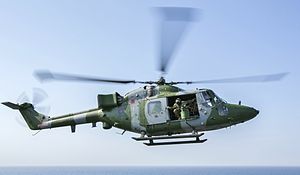Lynx WG13
| WG-13 Lynx / Super Lynx | |
|---|---|
 |
|
| A British Army Lynx in 2013 | |
| Role | Multi-purpose military helicopter |
| National origin | United Kingdom |
| Manufacturer |
Westland Helicopters AgustaWestland |
| First flight | 21 March 1971 |
| Introduction | 1978 |
| Status | In service |
| Primary users |
British Army Royal Navy retired 2017 French Navy German Navy |
| Produced | 1978–present |
| Number built | 450 (as of 2009) |
| Variants | AgustaWestland AW159 Wildcat |
| Developed into | Westland 30 |
The Westland Lynx is a British multi-purpose military helicopter designed and built by Westland Helicopters at its factory in Yeovil. Originally intended as a utility craft for both civil and naval usage, military interest led to the development of both battlefield and naval variants. The Lynx went into operational usage in 1977 and was later adopted by the armed forces of over a dozen nations, primarily serving in the battlefield utility, anti-armour, search and rescue and anti-submarine warfare roles.
The Lynx has the distinction of being the world's first fully aerobatic helicopter with the ability to perform loops and rolls. In 1986, a specially modified Lynx set the current Fédération Aéronautique Internationale's official airspeed record for helicopters at 400.87 km/h, which remains unbroken as of 2016.
In addition to a wide number of land and naval variants of the Lynx, several major derivatives have been produced. The Westland 30 was produced as a civil utility helicopter; it did not become a commercial success and only a small number were built during the 1980s. In the 21st century, a modernised variant of the Lynx was designed as a multirole combat helicopter, designated as the AgustaWestland AW159 Wildcat; the Wildcat is intended to replace existing Lynx helicopters. The Lynx remains in production by AgustaWestland, the successor to Westland Helicopters.
The initial design (then known as the Westland WG.13) was started in the mid-1960s as a replacement for the Westland Scout and Wasp, and a more advanced alternative to the UH-1 Iroquois. The design was to be powered by a pair of Bristol Siddeley BS.360 turboshaft engines. As part of the Anglo-French helicopter agreement signed in February 1967, the French company Aérospatiale were given a 30 per cent production work share in the programme, Westland performing the remainder. It was intended that France would procure the Lynx for its Navy and of a heavily modified armed reconnaissance variant for the French Army, with the United Kingdom in return buying Aérospatiale Gazelle and Puma for its armed forces. In October 1969, the French Army cancelled its requirement for the Lynx, thus development work of the dedicated armed attack variant was terminated early on.
...
Wikipedia
